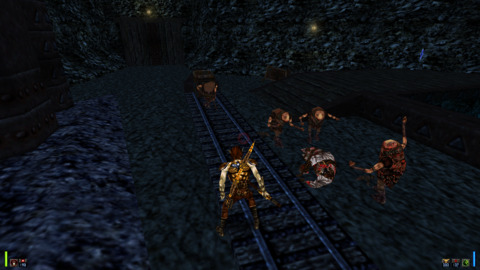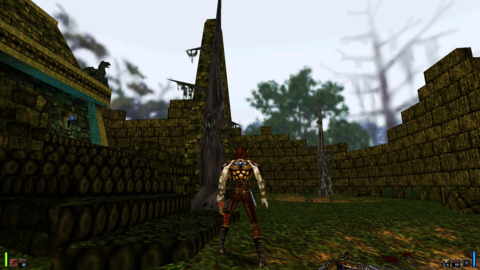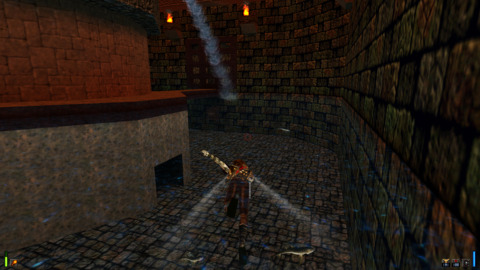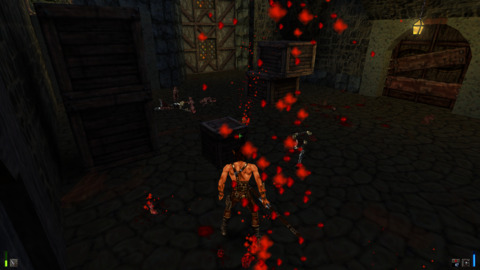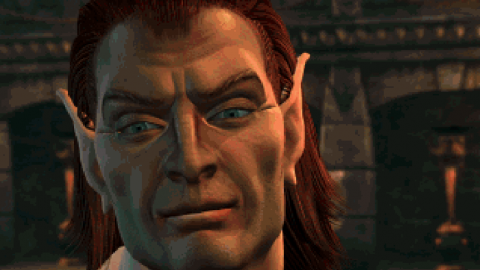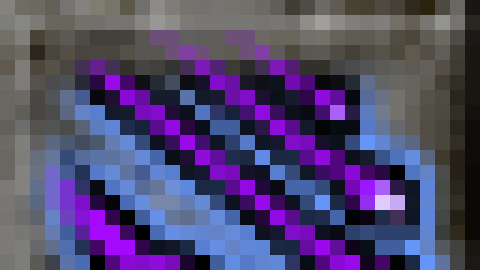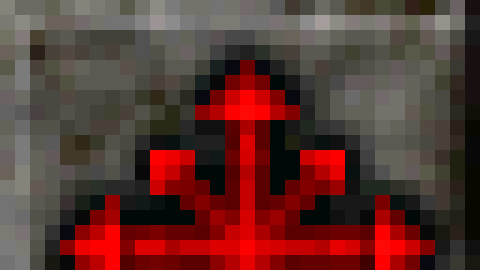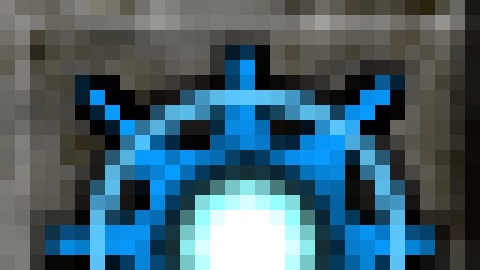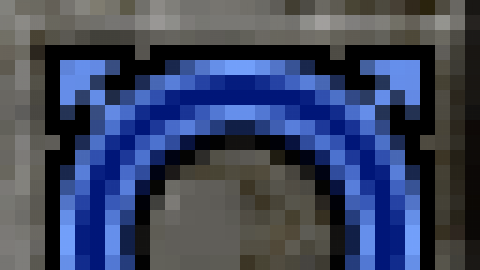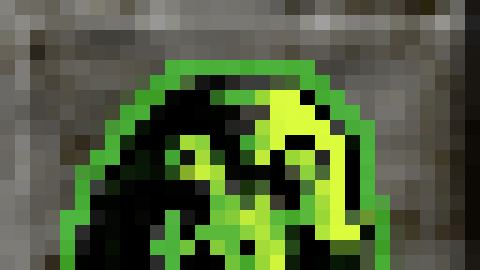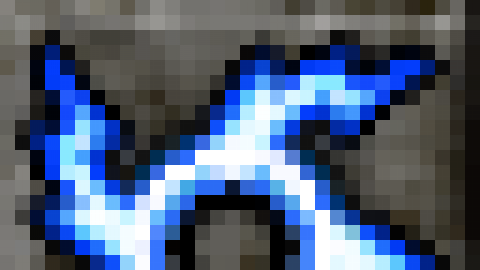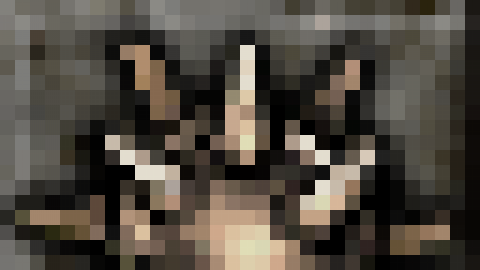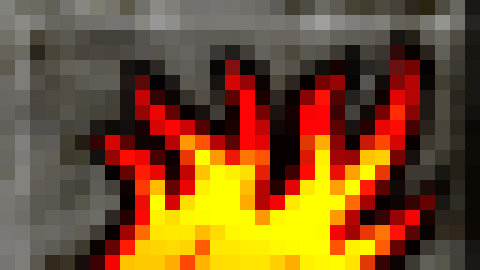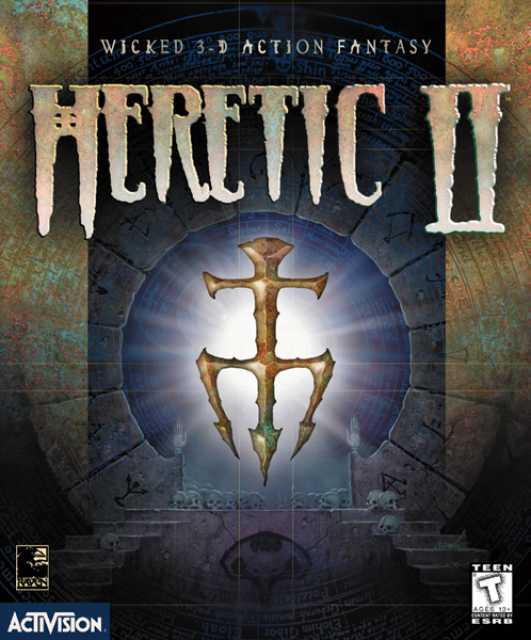Overview
Heretic II is the fourth title in Raven Software's Heretic franchise, which returns to the fantasy setting established in the first game, the troubled realm of Parthoris, while also revisiting the fortunes of its Sidhe protagonist, Corvus. As a sequel, it predictably contains many of the hallmarks of its forebears, but it also represents a marked departure from many of the qualities closely associated with the previous games in the series. The most prominent alteration from its predecessors is that of perspective, as Heretic II is a third-person action-adventure game rather than a first-person shooter in the vein of Heretic, Hexen, and Hexen II. Many changes were made to the series' combat mechanic in order to accommodate this design choice, though at its core, Heretic II is still an action-oriented title with light puzzle-solving elements in much the same way that previous titles were. One tradition that is thoroughly maintained in Heretic II is the franchise's continued use of licensed id Software technology. In this case Raven utilizes a heavily modified version of Quake II's id Tech 2 engine.
Plot

As the game opens, Corvus, the protagonist of Heretic II, is depicted fighting the deciding battle of Heretic, in which he ultimately prevails over the evil Serpent Rider D'Sparil, a demon mage responsible for throwing the entire realm of Parthoris into chaos. As Corvus strikes the decisive blow against the sorcerer, however, D'Sparil places a final curse upon him, the true nature of which he will not realize until he turns to leave. Entering a portal he believes will take him to the city of Silverspring, Corvus instead finds himself not in the welcoming streets of his home, but rather in the desolate wastes of the Outer Worlds, where he must fight for his very continued survival. After traversing the Outer Worlds for an unknown period of time, Corvus find the means to return to Silverspring, though it is not in the state he would have hoped.
Upon arriving, Corvus discovers that Silverspring, and in fact the world at large, has been afflicted by a plague that adversely affects both the minds and bodies of its victims. In hopes of finding a cure, he escapes the confines of the infected city, though not without contracting the disease himself, thus making his quest all the more urgent. As he continues, he eventually discovers that the culprit behind the sudden outbreak is a Seraph by the name of Morcalavin. Corvus initially has trouble believing this fact, as his people venerate the Seraphs as their ancestors, but when faced with the undeniable truth of Morcalavin's involvement, he reluctantly travels to the Seraph's inner sanctum where he uses the Tome of Power in his possession to cure Morcalavin of his insanity and put an end to his plague.
Gameplay
Though the gameplay of Heretic II strays from that of the previous games in significant ways, at its heart it still follows the basic Heretic formula of fast-paced action in a medieval fantasy setting. In addition to solving various Hexen-style environmental puzzles, players will consistently tackle heavy opposition over the course of the game, and must use whatever weapons and spells they can find to fend off their foes and ensure their own survival. In this respect it is no different from other games in the franchise. The primary influence of the third-person perspective on gameplay is seen in the game's increased emphasis on the importance of special maneuvers and player positioning. Players can perform more evasive maneuvers when encountering enemies than were possible in past games, and additional moves such as ledge grabs and pole vaults also allow players to traverse the environment in ways more similar to a platform game. Additionally, since players are able to see opponents on all sides, increased importance is placed on the player's ability to maintain an advantageous position in relation to their enemy, and more specifically to avoid being flanked or swarmed.
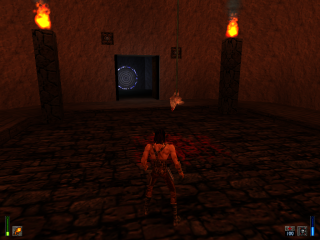
The way weaponry is handled in Heretic II can be seen as somewhat of a combination of the Heretic and Hexen systems. Like Heretic, there are certain weapons which are powered by their own independent ammo types, which must be collected and used for that particular weapon only. However, a separate system governed by green and blue mana, which was introduced in the Hexen games, is used to power anything designated as a spell, though the way in which they do so is unique to Heretic II. All offensive spells are powered by offensive (green) mana, while all defensive spells are powered by defensive (blue) mana. Any offensive or defensive mana collected can be used for any spell in its respective category, though a spell will always be strictly tied to a single type of mana only, unlike in the Hexen series where the most powerful of weapons used both.
Heretic II is also the first game in the franchise to completely eschew any sort of active inventory system. While important quest items will still be held in the player's invisible inventory for use when they are needed, players are no longer able to hold on to useful items and power-ups in order to use them when they deem fit. Certain usable items that have persisted throughout the series are used in different ways, however. The signature Quartz Flask, for instance, is immediately consumed upon pick-up in the same manner as the Crystal Vial, and other well-known items such as the Tome of Power and the Morph Ovum have been converted into defensive spells which can be cast at any time provided the user has enough blue mana.
Lastly, Heretic II introduces the concept of shrines to the series. In the absence of an inventory system, these act as the game's power-ups, imparting a variety of temporary and permanent enhancements to the player. These can range from the fairly mundane, such as the Light of the Seraph Shrine, which simply illuminates the immediate area around Corvus, to the immensely useful, like the Reflective Shrine, which briefly reflects all ranged attacks that strike the player. All shrines are single use only, and do not regenerate over time.
Races of Parthoris
While Corvus' dealings in Heretic mostly consisted of encounters with the depraved minions of D'Sparil, his quest in Heretic II brings him into direct contact with many of the main races of Parthoris, most of whom have been affected in one way or another by the onset of Morcalavin's plague. While Corvus will fight against most of them, none of them are truly evil, and their aggression toward Corvus is usually a direct result of plague infection.
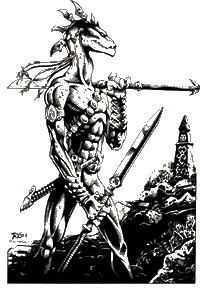 | The CauthoriansBeing warlike and aggressive above all else, the reptilian race known as the Cauthorians suffered greater casualties than most in the war that accompanies D'Sparil's arrival. Even when they are not fighting, the Cauthorian people are unified only by their dedication to martial prowess, as they maintain no organized government nor large permanent settlements. In Cauthorian culture, any individual who no longer possesses the will or ability to fight is considered little more than dead weight, and subsequently will be put to death. |
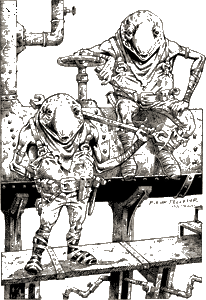 | The OglesOne of the most diminutive and meek of the races of Parthoris, the subterranean Ogles have had the misfortune of being brutalized and enslaved by larger and more aggressive races several times over the course of Parthoris' history. Understandably, this has led them to be extremely reclusive, and today the average Ogle prefers not to venture far beyond the underground mines that it calls home. When not being harassed by outsiders, the Ogles generally spend their time mining and honing their significant skills at metalworking. |
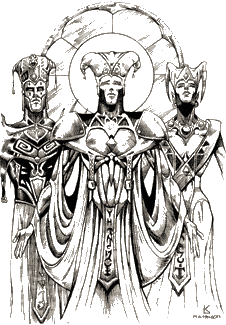 | The SeraphsA race of supreme magic-users said to have ruled the world in a time long past, the Seraphs exist today mostly in the minds of the Sidhe, who believe themselves to be descended from them. The decline of the Seraphs is one of the great mysteries of the world of Parthoris, as few can guess what would have led them, with their superior command of magic and the elements, to all but cease to exist. Today only rumors and the occasional sighting are all that remain of their once-great culture. |
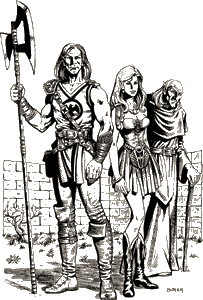 | The SidheThe slender elven people known as the Sidhe are the modern-day descendants of the Seraphs, and as such their kind still possesses much of the magical mastery that their ancestors once did. They were the only culture that did not submit to the rule of D'Sparil, though as a result the Serpent Lord hunted them nearly to extinction. In the years following D'Sparil's death, the Sidhe have rebuilt many of their cities, including Silverspring, and have begun to flourish once more. |
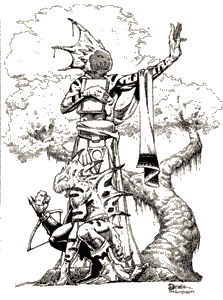 | The SsithraThe amphibious Ssithra race has traditionally devoted itself to scholarly and religious pursuits, building their cities in and around the marshlands and filling them with temples, libraries, and museums. Increasingly in more recent times, a new generation of Ssithra leaders have come into conflict with traditionalists, often decrying the old rituals of sacrifice still practiced by others to be outdated and barbaric. Though this has caused division among the Ssithra population to some degree, all Ssithra are dedicated to the pursuit of knowledge. |
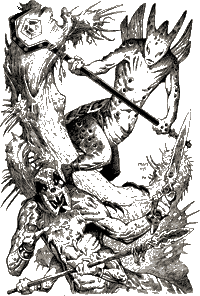 | The T'chekrikThe insectoid T'chekrik have thrived for generations within the wastelands of Parthoris, building vast underground cities which they defend fiercely. They are matriarchal society, perhaps due to the relatively small number of females that exist among them, and as a result almost all important decisions made in T'chekrik society are made by women. Males mostly serve as the warriors and protectors of their respective settlements, making sure that their homes are impregnable. Particularly noteworthy males may also be chosen as a mate. |
Weapons
Weapons are differentiated from spells in that they possess their own corresponding ammunition types rather than relying on offensive mana (with the exception being the Durhnwood Staff, which requires neither). This generally means that their use must be managed more carefully, as these ammo types are not found as frequently as mana.
 | Durhnwood StaffCorvus' trusty Durhnwood Staff (or Blade Staff) served him well during his time in the Outer Worlds, and it continues to do so after his return to Parthoris. The Blade Staff can be permanently upgraded two times over the course of the game. The first upgrade significantly increases its power, and the second adds a flame effect that will cause fire damage over time to any enemy it hits. If it is not fully upgraded, the Tome of Power will temporarily boost the Staff to the next upgrade level. |
 | HellstaffA rapid-fire weapon that makes its return from Heretic, the Hellstaff is Heretic II's closest equivalent to a machine gun. It is obtained fairly early on in the game, and is a fairly good way to dispatch targets before they can do much damage. Like most weapons with a high rate of fire, however, it expends its ammunition at an extremely fast rate, and for that reason is not a particularly good general-purpose weapon. The Tome of Power, increases its rate of fire even further, allowing targets to be taken down even faster. |
 | Storm BowThe Storm Bow fires a single arrow upon use which creates a magical storm of a red hue around its point of impact. Any target that remains within it will take damage for as long as they remain within the storm, and may also be hit by lightning. The obvious drawback of the weapon is the fixed nature of its storm cloud. Enemies need only move outside of its area of effect to avoid taking damage. The Tome changes the storm cloud to a greenish hue while giving it additional damage against its targets. |
 | Phoenix BowThe Phoenix Bow functions much as a rocket launcher would in a traditional first-person shooter. A single arrow travels in a straight line toward its target, exploding on impact and causing blast damage to any targets nearby. This splash damage is also strong enough to cause damage to a player if they are close enough to the explosion. Combining it with the Tome of Power increases the strength of the blast by enlarging the damage radius around the explosion. |
Offensive Spells
Offensive spells, as the name would entail, encompass any spell whose primary purpose is to cause direct damage to an enemy. All offensive spells draw upon offensive, or green, mana when used, and only one of the five can be used without it, and even then, this incurs a penalty to damage.
 | FireballThe game's starting offensive spell is unspectacular at best, but is noteworthy in that it is not entirely mana-dependent. That is to say, it can still be used, albiet with reduced efficacy, when a player's offensive mana has been depleted. It is a good weapon to use early on on distant enemies, but is quickly outclassed by later spells. The Tome of Power grants it additional power, but does not otherwise change its functionality in any way. |
 | Thunder BlastThe Thunder Blast can best be thought of as the shotgun of Heretic II. Its primary fire unleashes a spread of magical bolts in front of Corvus which can damage several enemies at a time, or cause significant damage to a single enemy when close enough. When used with a Tome, the spell's function changes significantly, releasing a focused group of three bolt at a single target rather than releasing an unfocused cone of bolts in the direction of its casting. |
 | FirewallTrue to its name, the Firewall spell unleashes a wall of flame that emanates in a semicircular arc from the player, immolating any and all targets it touches. This spell has its greatest effect when used on groups of enemies, especially those that cannot sustain much damage. The alternate fire provided through the Tome of Power alters the nature of the spell, changing it from an arc to a stream of fire which is projected directly in front of Corvus. |
 | Sphere of AnnihilationThe awesome Sphere of Annihilation spell is a powerful and mana-intensive spell which creates a large blue explosion. Its effect is very similar to that of the Phoenix Bow, so it is often more prudent to use Phoenix Arrows given the large amount of mana that Sphere of Annihilation consumes. The Tome-powered version is a very different spell which sends waves of energy out from either side of Corvus rather than straight ahead. |
 | Iron DoomThe Iron Doom spell is a powerful incantation which conjures a single spiked iron sphere which, when thrown, shatters into several others. Both the initial sphere and those that emanate from it cause damage, and the effect is quite similar to the tomed version of the Dragon Claw in the original Heretic. When the Tome of Power is invoked, a massive version of the sphere is thrown which bounces slowly along the ground, causing massive damage to anything it strikes. |
Defensive Spells
Utilizing blue defensive mana, spells which fall under the defensive category are those which are not designed to damage enemies directly or, in some cases, at all. None of the spells in this class are altered when the Tome of Power is invoked, meaning that their effects are consistent at all times.
 | Tome of PowerThe fabled Tome of Power can now be called upon at any time to amplify the power of all weapons and offensive spells, provided the player has sufficient mana. The effect is timed, and when active, a special bar indicating the length of time until expiration appears in the upper right of the screen. While it is an extremely useful spell, a single use of the Tome expends a large amount of blue mana, and so its use is best reserved for particularly tough situations. |
 | Ring of RepulsionThe Ring of Repulsion spell causes any creature within a close proximity of Corvus to be pushed back forcefully. This can be useful for a number of purposes, not least of which is providing the player with need breathing room when being swarmed. Since many levels in Heretic II are quite vertical, it can also be utilized to push enemies off of ledges (possibly to their deaths), essentially making it an improvised offensive spell. |
 | TeleportTeleport can be used in many of the same situations that Ring of Repulsion can, where it can instantly teleport the player out of harm's way and into a safe location nearby. Perhaps the greatest additional functionality afforded by the Teleport spell is its ability to save the player from bottomless pits, fiery magma, and the like, which Ring of Repulsion can't do. This is a bit difficult to accomplish in practice, however, as it requires fairly quick reflexes to accomplish. |
 | Meteor SwarmThe Meteor Swarm is a unique defensive option which summons three large boulders from the ground which rotate in a tight circle around Corvus. These rocks will then launch themselves at enemies automatically whenever one happens to be nearby. Since they require no targeting on the player's part, they are especially useful when dealing with enemies that are difficult to target manually, such as the deadly Harpies which populate many of the game's outdoor areas. |
 | Morph OvumWhen cast, the Morph Ovum spell sends out ring of egg-like projectiles in all directions. Any enemy unfortunate enough to be struck by one of the eggs will be instantly transformed into a helpless chicken. Whilst in their poultry form, enemies will not be able to attack, and will usually wander aimlessly around their environment. While humorous, the spell is temporary, so players must act quickly when using Morph Ovum to prevent foes from returning to their regular form. |
 | Lightning ShieldActivating the Lightning Shield will enshroud Corvus in a spherical ball of lightning. This sphere acts as a proximity shield, arcing out to shock foes with tendrils of electricity whenever they venture too close to the player. Unlike the Meteor Swarm, which consists of only three charges, the Lightning Shield will persist for a longer period of time, though the player is required to be much closer to their enemies in order to damage them. |

 Amiga
Amiga Mac
Mac PC
PC